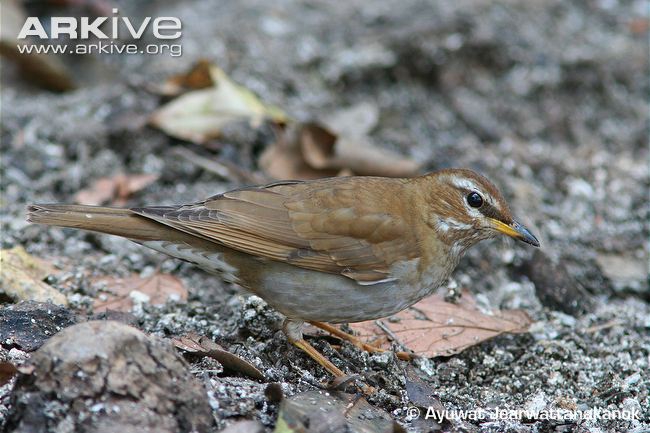| Citation |
|
Description |
Geographic Range [top]
Range Description: Turdus feae breeds in the mountains of north-east China, in Shanxi, Hebei and Beijing, where it is known from only a few scattered records. It has been recorded in winter from West Bengal, Assam, Meghalaya, Nagaland and Manipur, north-east India; Myanmar; north-west Thailand, and Laos. Its relatively small breeding range and the limited area of habitat remaining within it indicate that its population could be small. In the past, it was described as not rare in north-east India in winter, but there is only one recent record, which may indicate that it has declined. However, it is a frequent and annual visitor in small numbers to the mountains of north, west and north-east Thailand (P. Round in litt. 2012).
Countries occurrence:
Native:
China; India; Lao Peoples Democratic Republic; Myanmar; Thailand
Additional data:
? Continuing decline in area of occupancy (AOO): Yes
? Extreme fluctuations in area of occupancy (AOO): No ? Estimated extent of occurrence (EOO) - km2: 327000
? Continuing decline in extent of occurrence (EOO): Yes ? Extreme fluctuations in extent of occurrence (EOO): No
? Number of Locations: 11-100 ? Continuing decline in number of locations: Yes
? Extreme fluctuations in the number of locations: No ? Lower elevation limit (metres): 1000
? Upper elevation limit (metres): 2565
Range Map: Click here to open the map viewer and explore range.
Population [top]
Population: The global population is estimated to number 2,500-9,999 mature individuals, based on an analysis of records by BirdLife International (2001), who concluded that given the relatively small number of recent records and its apparent low population density, this species could have a small total population, i.e. fewer than 10,000 individuals. This estimate equates to 3,750-14,999 individuals, rounded here to 3,500-15,000 individuals. Brazil (2009) estimates the population in China at 100-10,000 breeding pairs and 50-1,000 individuals on migration.
Trend Justification: A moderate population decline is suspected to be occurring, owing to on-going pressure from habitat loss and degradation in the breeding and wintering ranges.
Current Population Trend: Decreasing
Additional data:
? Number of mature individuals: 2500-9999 ? Continuing decline of mature individuals: Yes
? Extreme fluctuations: No ? Population severely fragmented: No
? No. of subpopulations: 1 ? Continuing decline in subpopulations: Yes
? Extreme fluctuations in subpopulations: No ? All individuals in one subpopulation: Yes
? No. of individuals in largest subpopulation: 100
Habitat and Ecology [top]
Habitat and Ecology: It breeds in temperate zone deciduous oak Quercus forest and pine Pinus forest in the mountains, between c.1,000-1,900 m. It winters in evergreen forest, mostly between c.1,000-2,600 m, although there are records down to sea level (W. Limparungpatthanakij in litt. 2016).
Systems: Terrestrial
Continuing decline in area, extent and/or quality of habitat: Yes
Generation Length (years): 6.1
Movement patterns: Full Migrant
Threats [top]
Major Threat(s): It is threatened by the continued loss and fragmentation of its habitat, principally in its breeding range. In China, deciduous broadleaved forest in Shanxi and Hebei is estimated to cover less than 20% of its original extent. Forests in Thailand and Myanmar have been affected by shifting agriculture, wood-collection and fires, but the extent of these threats has declined in this area and some forest is regenerating (P. Round in litt. 2012).
Conservation Actions [top]
Conservation Actions: Conservation Actions Underway
CMS Appendix II. It has been recorded in several protected areas in its breeding range including Pangquangou National Nature Reserve in Shanxi, Lao Ling Nature Reserve in Hebei and Baihuashan Nature Reserve in Beijing. There are several other protected areas in Shanxi and Hebei where it could occur, notably reserves established for the conservation of Brown-eared Pheasant Crossoptilon mantchuricum. Several wintering sites are protected, including Natma Taung National Park (Mt Victoria-Myanmar), Doi Suthep-Pui and Doi Inthanon, and Doi Pha Hom Pok National Parks, Om Koi Wildlife Sanctuary, Mae Ping National Park, Mae Wong National Park, Thung Yai Naresuan and Huai Kha Khaeng Wildlife Sanctuaries, Kaeng Krachan National Park (Thailand. W. Limparungpatthanakij in litt. 2016), and Nakai-Nam Theun National Biodiversity Conservation Area (Laos).
Conservation Actions Proposed
Conduct surveys to determine whether it occurs in other reserves established for Brown-eared Pheasant. Research its ecology to establish its breeding habitat requirements and altitudinal range, with the aim of developing appropriate forest management regimes in protected areas where it occurs. Promote the extension of Pangquangou National Nature Reserve, and strengthen protection at Lao Ling and Baihuashan Nature Reserves (China). Reforest suitable degraded areas (P. Round in litt. 2012). List as a protected species in China.
Citation: BirdLife International. 2016. Turdus feae. The IUCN Red List of Threatened Species 2016: e.T22708790A94176865. http://dx.doi.org/10.2305/IUCN.UK.2016-3.RLTS.T22708790A94176865.en. Downloaded on 07 February 2017.
Disclaimer: To make use of this information, please check the .
Feedback: If you see any errors or have any questions or suggestions on what is shown on this page, please provide us with feedback so that we can correct or extend the information provided
|

